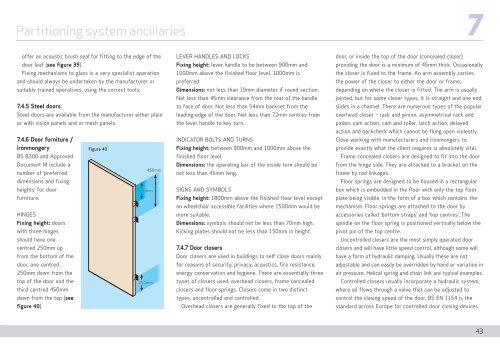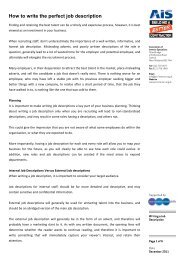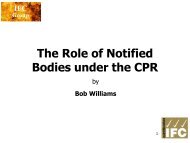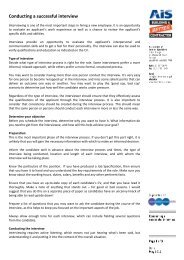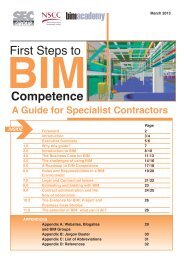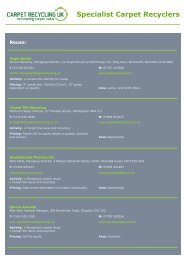6 - Association of Interior Specialists
6 - Association of Interior Specialists
6 - Association of Interior Specialists
- No tags were found...
Create successful ePaper yourself
Turn your PDF publications into a flip-book with our unique Google optimized e-Paper software.
Partitioning system ancillaries 7<strong>of</strong>fer an acoustic brush seal for fitting to the edge <strong>of</strong> thedoor leaf (see figure 39).Fixing mechanisms to glass is a very specialist operationand should always be undertaken by the manufacturer orsuitably trained operatives, using the correct tools.7.4.5 Steel doorsSteel doors are available from the manufacturer either plainor with vision panels and or mesh panels.7.4.6 Door furniture /ironmongeryBS 8300 and ApprovedDocument M include anumber <strong>of</strong> ‘preferreddimensions and fixingheights’ for doorfurniture.HINGESFixing height: doorswith three hingesshould have onecentred 250mm upfrom the bottom <strong>of</strong> thedoor, one centred250mm down from thetop <strong>of</strong> the door and thethird centred 450mmdown from the top (seefigure 40).Figure 40250mm250mm450mmLEVER HANDLES AND LOCKSFixing height: lever handle to be between 900mm and1000mm above the finished floor level, 1000mm ispreferred.Dimensions: not less than 19mm diameter if round section.Not less than 45mm clearance from the rear <strong>of</strong> the handleto face <strong>of</strong> door. Not less than 54mm backset from theleading edge <strong>of</strong> the door. Not less than 72mm centres fromthe lever handle to key turn.INDICATOR BOLTS AND TURNSFixing height: between 900mm and 1000mm above thefinished floor level.Dimensions: the operating bar <strong>of</strong> the inside turn should benot less than 45mm long.SIGNS AND SYMBOLSFixing height: 1800mm above the finished floor level excepton wheelchair accessible facilities where 1500mm would bemore suitable.Dimensions: symbols should not be less than 70mm high.Kicking plates should not be less than 150mm in height.7.4.7 Door closersDoor closers are used in buildings to self close doors mainlyfor reasons <strong>of</strong> security, privacy, acoustics, fire resistance,energy conservation and hygiene. There are essentially threetypes <strong>of</strong> closers used; overhead closers, frame concealedclosers and floor springs. Closers come in two distincttypes, uncontrolled and controlled.Overhead closers are generally fixed to the top <strong>of</strong> thedoor, or inside the top <strong>of</strong> the door (concealed closer)providing the door is a minimum <strong>of</strong> 45mm thick. Occasionallythe closer is fixed to the frame. An arm assembly carriesthe power <strong>of</strong> the closer to either the door or frame,depending on where the closer is fitted. The arm is usuallyjointed, but for some closer types, it is straight and one endslides in a channel. There are numerous types <strong>of</strong> the popularoverhead closer – rack and pinion, asymmetrical rack andpinion, cam action, cam and roller, latch action, delayedaction and backcheck which cannot be flung open violently.Close working with manufacturers and ironmongers toprovide exactly what the client requires is absolutely vital.Frame concealed closers are designed to fit into the doorfrom the hinge side. They are attached to a bracket on theframe by rod linkages.Floor springs are designed to be housed in a rectangularbox which is embedded in the floor with only the top floorplate being visible, in the form <strong>of</strong> a box which contains themechanism. Floor springs are attached to the door byaccessories called ‘bottom straps’ and ‘top centres’. Thespindle on the floor spring is positioned vertically below thepivot pin <strong>of</strong> the top centre.Uncontrolled closers are the most simply operated doorclosers and will have little speed control, although some willhave a form <strong>of</strong> hydraulic damping. Usually these are notadjustable and can easily be overridden by hand or variation inair pressure. Helical spring and chain link are typical examples.Controlled closers usually incorporate a hydraulic system,where oil flows through a valve that can be adjusted tocontrol the closing speed <strong>of</strong> the door. BS EN 1154 is thestandard across Europe for controlled door closing devices.43


